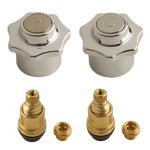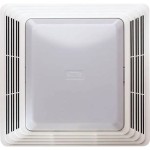Single Handle Bathroom Faucet Replacement
Replacing a single handle bathroom faucet is a relatively straightforward task that can be completed in about an hour. With a few simple tools and a little bit of know-how, you can save yourself the cost of hiring a plumber. Here's a step-by-step guide to help you get the job done.
Tools and Materials You'll Need
- Adjustable wrench
- Basin wrench (optional)
- Phillips head screwdriver
- Flat head screwdriver
- New single handle bathroom faucet
- Plumber's putty
- Teflon tape
Step-by-Step Instructions
1. Turn Off the Water Supply
Before you start working on the faucet, you need to turn off the water supply. There should be two shut-off valves under the sink, one for the hot water and one for the cold water. Turn both valves clockwise to turn off the water.
2. Disconnect the Old Faucet
Once the water is turned off, you can disconnect the old faucet. Start by removing the aerator, which is the small screen at the end of the faucet spout. Use a pair of pliers or a wrench to unscrew the aerator.
Next, use an adjustable wrench or a basin wrench to loosen the nuts that hold the faucet in place. Be careful not to overtighten the nuts, as this can damage the faucet.
Once the nuts are loose, you can pull the faucet straight up to remove it.
3. Install the New Faucet
Before you install the new faucet, apply a thin bead of plumber's putty to the base of the faucet. This will help to seal the faucet and prevent leaks.
Next, wrap a few layers of Teflon tape around the threads of the faucet's mounting bolts. This will also help to prevent leaks.
Insert the faucet into the mounting holes in the sink. Thread the mounting bolts through the holes and tighten them with an adjustable wrench or a basin wrench. Be sure to tighten the bolts evenly to prevent the faucet from leaking.
4. Reconnect the Water Supply
Once the faucet is installed, you can reconnect the water supply. Turn on the shut-off valves under the sink and check for leaks. If there are any leaks, tighten the mounting bolts or the aerator until they stop.
5. Test the Faucet
Once the water supply is reconnected, turn on the faucet and check for leaks. If there are no leaks, your new single handle bathroom faucet is installed correctly. Congratulations!
Tips
- If you have a difficult time removing the old faucet, you can try using a penetrating oil to loosen the nuts.
- Be sure to clean the sink before you install the new faucet. This will help to prevent dirt and debris from getting trapped in the faucet and causing leaks.
- If you have any questions or concerns, be sure to consult with a qualified plumber.

How To Install A Single Handle Bathroom Faucet Hansgrohe S Talis Select

Valley Single Handle Bathroom Faucet Repair Parts

Single Handle Bathroom Faucet And Drain Replacement Easy Step By Tips For Beginners

P131lf Single Handle Bathroom Faucet

Bathroom My Single Handle Faucet Is Leaking Or Dripping

Repair Parts For One And Two Handle Delta Bathroom Faucets

P131lf Single Handle Bathroom Faucet

How To Fix A Leaky Single Handle Sink Faucet

How To Install A Single Handle Bathroom Faucet Hansgrohe S Talis Select

How To Fix A Leaky Single Handle Sink Faucet
See Also







